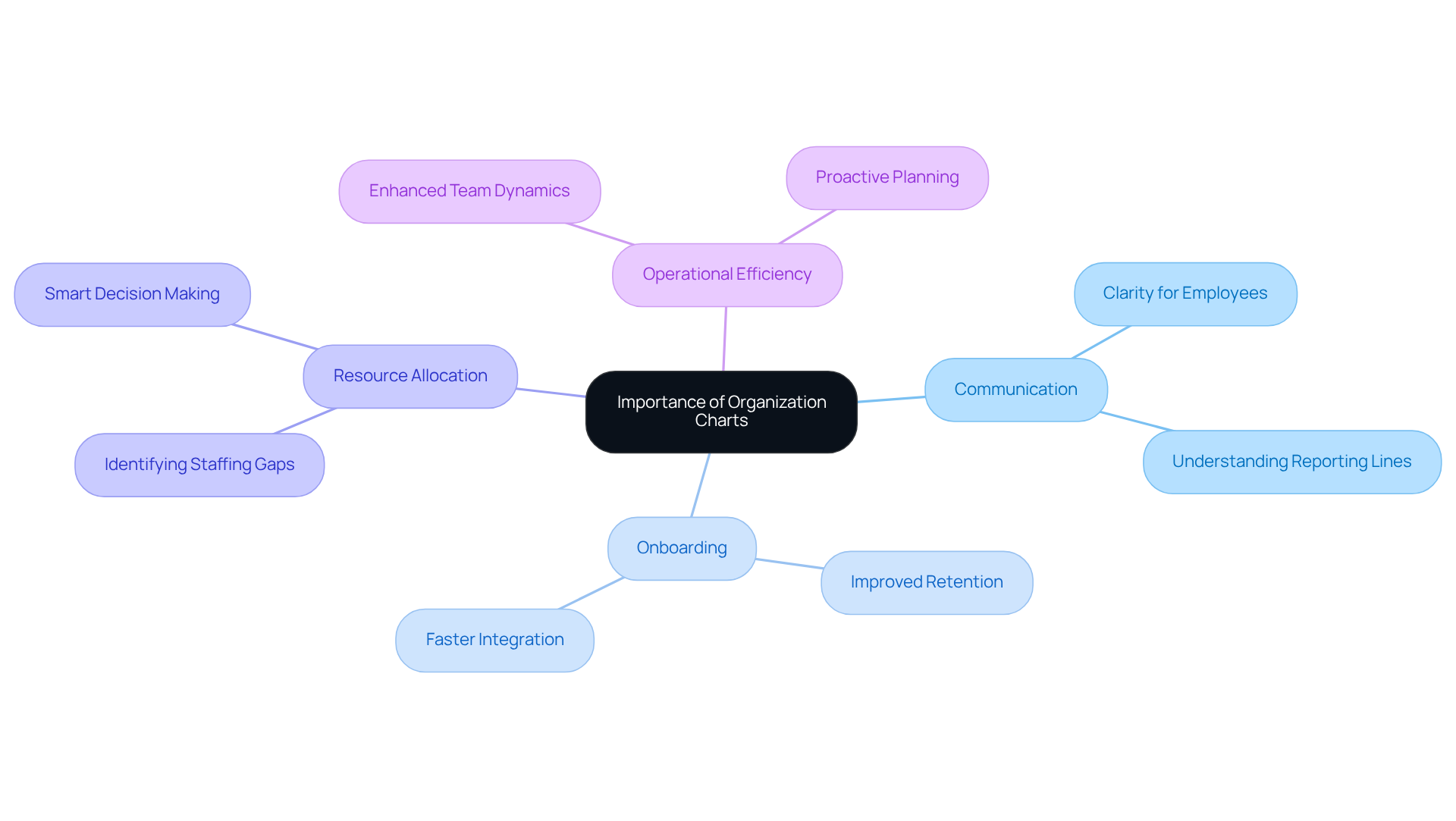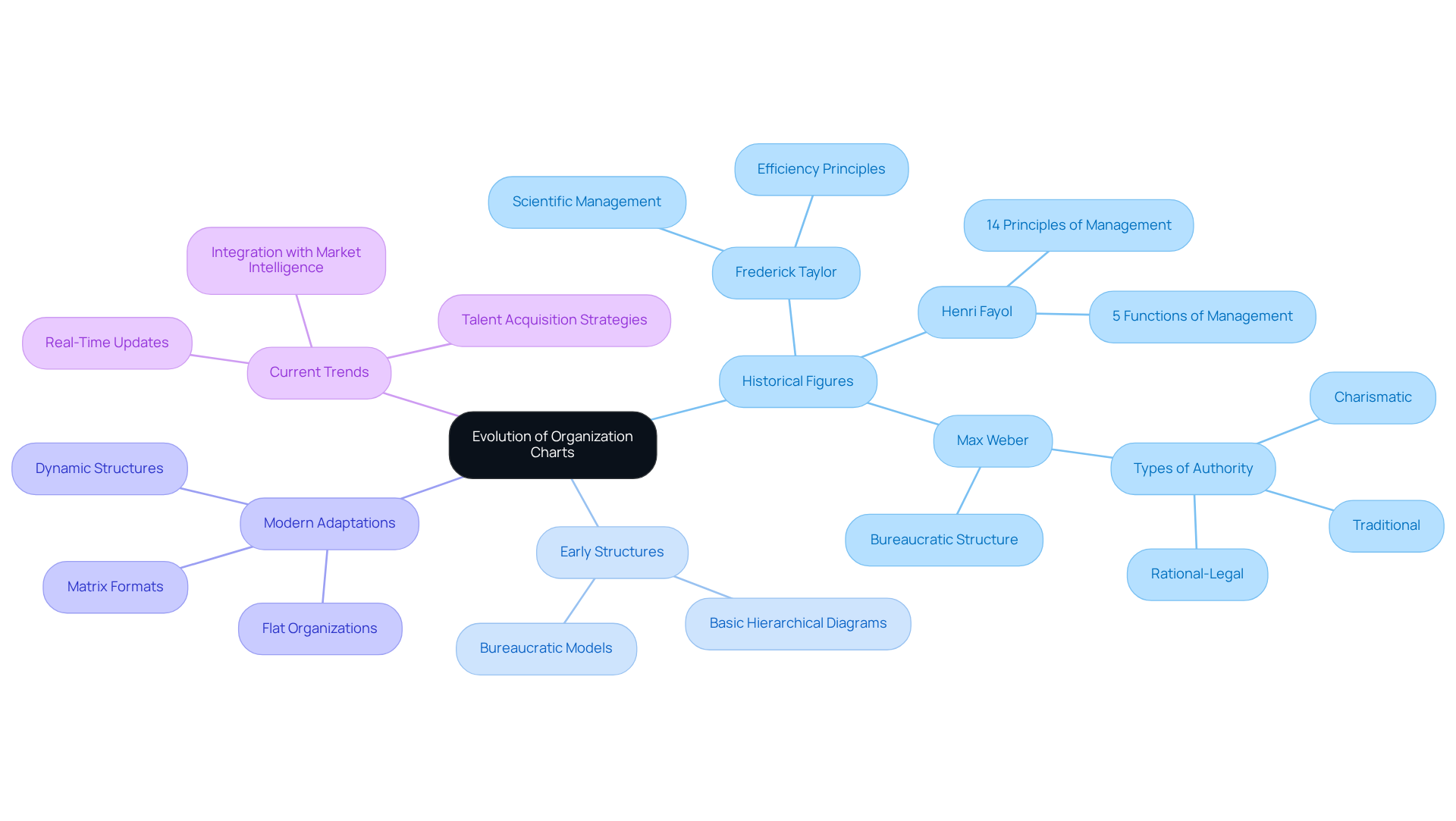
Overview
You might be wondering why organization charts matter. Well, they’re essential tools that visually lay out a company’s structure, showing roles, responsibilities, and reporting relationships. This clarity boosts communication and helps things run smoothly. Plus, the article points out that organization charts are super important for:
- Onboarding new folks
- Strategic planning
- Spotting staffing gaps
When done right, these charts can really enhance how employees understand their roles and make decisions within the organization. So, let’s dive into how effective organization charts can make a difference!
Key Highlights:
- An organisation chart is a visual representation of a company's structure, showing roles, responsibilities, and reporting relationships.
- These diagrams enhance employee understanding, communication, and collaboration within an organisation.
- Effective organisation charts aid in onboarding new employees by providing clarity about roles and reporting lines.
- Structural diagrams help identify staffing gaps and improve resource allocation and team dynamics.
- The evolution of organisation charts reflects changes in management practises, moving from simple hierarchies to more complex structures.
- Key components of organisation charts include lines of authority and span of control, which impact communication and efficiency.
- Organisation charts support strategic planning and change management, particularly during mergers and acquisitions.
- Keeping organisation charts updated is crucial, as they can become outdated within nine months, potentially leading to operational inefficiencies.
Introduction
You might be wondering what an organization chart really is. Well, it’s that handy visual tool that lays out a company’s structure, showing who does what and how everyone connects. These charts are crucial because they clarify reporting lines and departmental roles, making communication smoother and operations more efficient. But here’s the kicker: as companies grow and face new challenges, how can they keep their organizational charts up-to-date and effective in boosting collaboration and efficiency? Let’s dive into that!
Define Organization Chart: A Visual Representation of Structure
You might be wondering about the purpose of a structure diagram, often called an org diagram. Well, it’s essentially a visual representation of a group's framework. It lays out roles, responsibilities, and the relationships between various positions within a company. Typically, an organization chart shows hierarchical relationships, making it clear who reports to whom and covering multiple levels of management and staff. This visual tool is super helpful for employees, as it boosts their understanding of their roles and how they fit into the bigger picture. An organization chart shows a clear view of the organizational framework, which helps improve communication and collaboration among teams.
Now, let’s talk about why management specialists emphasize the importance of these diagrams. They play a crucial role in enhancing employee understanding. For instance, W.B. Yeats once said that education is about sparking curiosity and comprehension—much like how an organizational diagram clarifies the routes of accountability within a company. Plus, effective structure diagrams can significantly boost communication by offering a clear summary that helps employees navigate their interactions with coworkers and leadership.
But wait, there’s more! The importance of structural diagrams goes beyond just being a pretty picture; they’re vital for creating a cohesive business framework. An organization chart shows how clearly defining roles and relationships helps prevent confusion and streamline decision-making processes. Companies that have established well-structured frameworks often see better communication and operational effectiveness. For example, organizations that have revamped their systems have reported efficiency boosts, like a 24.1% increase in baggage services efficiency. And let’s not forget [Cisco, whose organizational framework has been praised](https://ibscdc.org/Case_Studies/Human Resource and Organization Behavior/Human Resource and Organization Behavior/Cisco Organizational Structure-Decision Making-Case Studies.htm) for improving decision-making and operational efficiency, showcasing the real-world benefits of a well-defined organizational layout.

Contextualize the Organization Chart: Importance in Business Operations
You might be wondering how an organization chart shows its role in the big picture of business operations. Well, they’re actually pretty crucial! These diagrams provide the clarity and organization that help everyone communicate effectively. Think of them as a roadmap for employees, guiding them through the company and helping them understand reporting lines and departmental functions. An organization chart shows the visualization of roles and responsibilities, which can significantly cut down on confusion and is super important for fostering a collaborative work environment.
Now, let’s talk about onboarding. An organization chart shows that structural diagrams are a fantastic resource for new employees, providing a clear visual guide to the company’s framework. This clarity helps new hires quickly grasp their roles, making it easier for them to integrate into the team. Research shows that a well-designed onboarding process can boost employee retention and productivity, so it’s clear that having a solid structure in place during this phase is essential.
But that’s not all! Structure diagrams also play a vital role in spotting gaps in staffing and areas that need improvement. An organization chart shows the hierarchy and roles within the organization, enabling managers to make smarter decisions about resource allocation and team dynamics. This proactive approach not only enhances operational efficiency but also supports strategic planning, ensuring the company is well-equipped to meet its goals.
For instance, businesses that effectively use structural diagrams have reported much better onboarding experiences. New employees feel more connected and informed right from day one! Experts emphasize that incorporating these diagrams into the onboarding process can really cut down the time it takes for new hires to adjust, resulting in a more engaged and efficient workforce.
Speaking of making things easier, SowFlow's immediate documentation solution really helps streamline this process. It allows companies to create and manage structure diagrams effortlessly, keeping these visuals relevant and accessible. In summary, structural diagrams are key to optimizing business operations and enhancing the onboarding experience—especially when you have tools like SowFlow that make documentation management a breeze!

Trace the Evolution of Organization Charts: Historical Significance
You might be curious about how structure charts came to be. Well, they popped up in the early 20th century, right alongside the rise of formal management theories. Think of folks like Henri Fayol and Max Weber, who really pushed the idea of organizational design. This push led to the creation of visual tools that illustrate what an organization chart shows regarding these hierarchies. Max Weber even said, "The enforcement of guidelines and protocols is designed to prevent any clash of personalities," which really highlights how important clear frameworks are for groups.
At first, an organization chart shows pretty basic, simple hierarchical diagrams. But guess what? They've come a long way! Now, we see more complex representations, like matrix formats and flat organizations. This shift mirrors the changes in management practices and structural dynamics, adapting to modern businesses that crave flexibility and collaboration. And let’s not forget Frederick Taylor’s scientific management ideas—they had a big hand in shaping these frameworks too.
Today, an organization chart shows that structural diagrams can be quite dynamic. Thanks to software, they can be updated in real-time as frameworks evolve. Did you know that the typical half-life of an organizational structure is about nine months before it starts to look unreliable? That really drives home the need for organizations to keep their representations accurate and up-to-date. Plus, with clients increasingly demanding organizational diagrams alongside market intelligence reports, these tools are becoming essential in talent acquisition strategies. In a world that’s always changing, this adaptability is key for responsive organizational designs. So, how are you keeping up with these changes in your own organization?

Identify Key Components: Lines of Authority and Span of Control
You might be wondering what makes a structure chart tick. Well, key elements include lines of authority and span of control. Think of lines of authority as the threads that connect various positions, showing who reports to whom. This visual map is super helpful for grasping what an organization chart shows about the hierarchy within an organization.
Now, let’s talk about span of control. It’s all about how many direct reports a manager oversees, and it plays a big role in how efficiently a company runs and how well communication flows. Kimberlee Henry puts it nicely: 'The term 'span of control' plays a pivotal role in structure.' A narrow span of control means closer supervision and more direct communication, which helps managers give tailored support and guidance. On the flip side, a wider span can allow team members more freedom, speeding up decision-making and sparking innovation.
For example, in a sales team, you might find that an average span of control is around ten salespeople per manager—this strikes a balance between oversight and independence. But keep in mind, a narrow span of control can sometimes lead to limited scalability and even micromanagement.
So, understanding these elements is key to interpreting structure diagrams, and an organization chart shows how to use them effectively in planning and management, ultimately boosting productivity and operational success. Plus, it’s crucial to align the span of control with the complexity and culture of the organization. Catherine Scott emphasizes this well: "If the manager’s span of control is not optimum, then this can lead to a lack of delegation, micromanagement, and miscommunication.

Practical Applications of Organization Charts in Modern Businesses
In today’s corporate world, you might be wondering how structural diagrams fit into the big picture. Well, they play some pretty essential roles in areas like strategic planning, personnel management, and change management. When companies go through mergers or acquisitions, these diagrams become crucial for showing how two entities will come together. They help clearly define roles and responsibilities in the new setup. This clarity is super important because, let’s face it, poorly managed integrations can lead to significant operational hiccups. In fact, research shows that failure rates for M&A transactions can soar as high as 90%! That’s why doing a Current State Analysis before making any changes is key to a smooth integration, ensuring everyone is ready for the transition.
Now, let’s talk about workforce planning. Organizational diagrams really shine here by helping to spot skill gaps and guiding targeted recruitment strategies. By laying out current competencies, companies can align their hiring efforts with what they actually need, which boosts productivity and efficiency. Plus, these diagrams speed up the hiring process by providing a visual representation of talent pools, making it easier for companies to see their recruitment landscape. And when it comes to change management, they offer a structured way to communicate shifts in roles or organizational structure to employees, reducing uncertainty and making transitions smoother. Just a heads-up: it’s crucial to keep these diagrams updated, as they can become outdated pretty quickly—usually within about 9 months—to avoid operational inefficiencies.
Using structural diagrams effectively not only brings clarity and enhances communication but also creates a collaborative vibe within the organization. They can reveal if unrelated personnel are juggling multiple tasks, which can help pinpoint inefficiencies and boost employee performance. As businesses tackle the complexities of today’s market, an organization chart shows how leveraging these structures becomes increasingly vital for driving growth and maintaining a competitive edge. So, how are you planning to use these tools in your own organization?

Conclusion
You might be wondering how an organization chart fits into the big picture of your company. Well, it’s more than just a pretty diagram; it’s a vital visual that lays out your company’s structure. It shows roles, responsibilities, and how everyone connects with each other. This clarity not only boosts communication and teamwork but also helps each employee see how they play a part in the organization’s mission. By clearly defining reporting lines and departmental functions, these charts make it easier for employees to navigate their roles within the corporate framework.
Throughout this article, we’ve touched on the many benefits of organization charts. They make onboarding a breeze, help with strategic planning, and even pinpoint staffing gaps, which can lead to smoother operations overall. Plus, as they’ve evolved over time and adapted to modern tools, these diagrams have become essential for any organization looking to thrive in today’s fast-paced business world.
In a landscape where clarity and collaboration are key, using organization charts can really amp up your business operations. As companies keep changing and growing, embracing these tools will not just help with communication but also support strategic growth and keep employees engaged. So, it’s a good idea for organizations to regularly update their structural diagrams, ensuring they stay relevant and effective in driving success.
Frequently Asked Questions
What is an organization chart?
An organization chart, or org diagram, is a visual representation of a group's framework that outlines roles, responsibilities, and relationships between various positions within a company. It typically shows hierarchical relationships, clarifying who reports to whom.
How do organization charts improve employee understanding?
Organization charts enhance employee understanding by providing a clear view of the organizational framework, which helps employees grasp their roles and how they fit into the bigger picture. This clarity boosts communication and collaboration among teams.
Why are organization charts important for communication?
Organization charts play a crucial role in enhancing communication by offering a clear summary of roles and relationships, helping employees navigate their interactions with coworkers and leadership effectively.
How do organization charts contribute to decision-making processes?
Well-structured organization charts prevent confusion by clearly defining roles and relationships, which streamlines decision-making processes and improves operational effectiveness.
What benefits have companies experienced from using organization charts?
Companies with established organization charts often report better communication and operational efficiency. For example, some organizations have seen a 24.1% increase in baggage services efficiency after revamping their systems.
How do organization charts assist in the onboarding process?
Organization charts serve as a valuable resource for new employees by providing a clear visual guide to the company's framework, helping them quickly understand their roles and integrate into the team.
What role do organization charts play in identifying staffing gaps?
Organization charts help managers spot gaps in staffing and areas needing improvement by visualizing the hierarchy and roles within the organization, enabling smarter decisions about resource allocation and team dynamics.
How can tools like SowFlow enhance the use of organization charts?
SowFlow's immediate documentation solution allows companies to create and manage organization charts effortlessly, keeping these visuals relevant and accessible, thus optimizing business operations and enhancing the onboarding experience.
👍
What others are liking
5 Steps to outline your ideal documentation structure
5 MINS READ
Where to start the your journey of mapping out your ideal documentation structure, aligning it with the very heartbeat of your organization?
Defining a winning level of detail in your process
3 MINS READ
What is too much detail, and what is too little? This article described in that winning level detail about what detail is enough.





